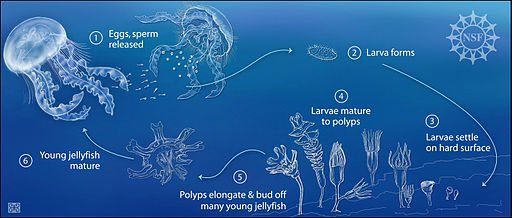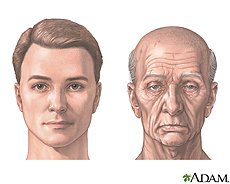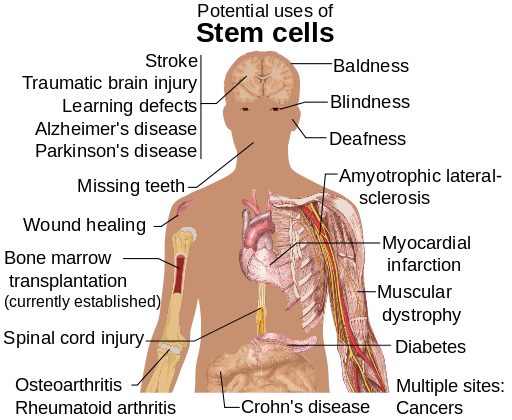HUMAN AGING, AN UNDYING FISH AND THE CONCEPT OF TRANSDIFFERENTIATION
I’ve always been fascinated about the concept of immortality, something about living forever or at least for a very long time excites me, not least cause death isn’t a pretty thought, but you get to witness a lot of things, evolution for example, what I would give to witness the next big stage in human evolution. One of my favorite TV series is titled “the originals”, I love this series majorly cause of the protagonist who sometimes is the antagonist, man by the name of Niklaus Michaelson, a type of marvels loki-esque character, you hate him but most of the time you love him (bit of a mischief that one), he is over a thousand year old original werewolf-vampire hybrid who can only be killed by a stake carved from some white oak tree which his family burned to the ground a thousand year ago, and that technically makes him immortal.
I’d love to be like Niklaus, minus the insatiable hunger for blood of course and I’d definitely love to be considered as living (technically Klaus is dead, being a vampire and all) but seeing as the letter “D” in MR NIGER DAC (an acronym for Movement, Respiration, Nutrition, Irritability, Growth, Excretion, Reproduction, Death, Adaptability and Competition, things considered as the characteristics of living things) clearly stands for Death and not “Darn cute” it seems all hope is lost for me, or is it?
Recently I found out about an animal who refuses to follow the rules set by MR NIGER DAC and just won’t die, it got me thinking how does it do it? Can we also do the same one day? So I went ahead and made some research about it and found some pretty cool stuff which I’d love to share with you today, so sit back and relax with some popcorn while I talk about Turritopsis Dohrnii aka The Immortal Jellyfish.
You stand in the presence of turritopsis dohrnii of house (family) Clavidae, order of Hydroida, the rightful queen/king of jellyfishes, first of its kind, the undying, the breaker of rules (lol).
The immortal jellyfish is currently the only known animal to be biologically immortal, originally discovered in the Mediterranean Sea in 1883[1], it’s about 5mm in diameter and like any other jellyfish has an umbrella shaped head, it start its life out just like most jellyfish as a larva which floats around in the sea before settling down on some rock on the bottom of the ocean where it then develops mouth and tentacles before transforming into what is known as a polyp, the polyps then bud off after a while releasing several tiny jellyfishes known as ephyra which later develops into an adult jellyfish known as the medusa, the medusa depending on its gender would either release sperm into the oceans or produces eggs to be fertilized by the sperm and then release new larva again then the cycle repeats itself[2].
So far T.dohrnii seems like any other jellyfish except for the fact that during times of stress, starvation, injury or any kind of accident, rather than giving up on life, it reverts back to its polyp stage and grows back again into adulthood, so in theory, the immortal jellyfish never dies of old age as it just keeps turning back the hands of time and reliving its youthful days while making sure it clones itself by budding off several tiny ephyra’s which grows into medusa’s again (fascinating stuff really) and all this is achieved through a process known as transdifferentiation.
I know you want me to talk about transdifferentiation now but we’ll get back to that, let’s take a quick detour and talk about what aging really is.
We are born so young and then we grow and keep growing till time takes its toll on us then we don’t feel so young again, the grey hair starts showing, the hair line starts receding and we become bald, standing up after sitting for so long seems to be an herculean task, the wrinkles appear on our skin, the eyes don’t see as clearly as they used to and the ears can’t pick up sound the way they used to, it seems to be the order of things in life, we are born, then we grow old and we die, death it seems is inevitable, if you are so lucky to avoid life threatening accidents, the grim reaper just sits and chill with a bottle of Pepsi while it waits for aging to take its toll on us then it comes for its price.
This simple fact has led scientist to try to understand what causes aging and maybe, just maybe it can be reversed or at least slowed down.
Two major theories which has been used to explain the cause of aging by modern biologists are
- Programmed theory
- Damaged theory
The programmed theory affirms that aging is a programmed process which can be looked at as a kind of biologically programmed timetable which tells when certain developments process occur in the body such as when we grow our first set of teeth or when we reach sexual maturity, this theory can be further explained using three systems which are the genes, immune system and the hormones. It claims that certain genes, hormones, and our immune system are already programmed to regulate aging in the body of organisms and by mutating such genes or reducing some hormones, the lifespan of such organism can be extended, for example, it is found that by mutating one gene in roundworms, C. elegans, its lifespan can be significantly lengthened, also by mutating certain genes which would reduce the amount of hormone IGF-1 (insulin like growth factor) would extend organisms life span.
This theory gained traction after Charles Darwin proposed his theory of evolution by natural selection, one of the first proponent of this theory is August Weismann in 1891 who proposed that aging is used by evolution to eliminate weaker animals or organisms to make way for a new generation. This theory however was later dismissed after the discovery that natural selection is found to only affect reproductive success of individuals and not whether a group would survive or not, also it can be said that the fact that life can be extended by mutating genes or reducing hormones doesn’t necessarily mean that such genes or hormones were naturally programmed to restrict a lengthier lifespan and this has led to scientists preferring the damaged theory.The damaged theory as the name implies suggest that aging is as a result of damages which has been done to an organisms cell over a long period of time, it compares the human body to machines which after being used for a long time starts breaking down and even if the cells in the body are replaced regularly, just like a car whose parts is regularly changed, at some point it’s just better to take the damn thing to a car crusher, this is one example of the damaged theory known as the Wear and Tear Theory, another example is the Cross Linkage Theory which is based on the fact that our DNAs and proteins creates unnecessary links over time through a process known as glycation whereby glucose molecules can stick to proteins, thereafter they form brownish molecules known as Advanced Glycosylation End products (AGEs), the sticky ends of AGEs can then attach to the next protein thereby forming these links, the links disables the functions of proteins and other structural molecules it might be attached to by decreasing their mobility and elasticity.
Researchers has proven that cross linkages is responsible for certain age related problems such as wrinkles which is caused by cross linking of the skin protein collagen. Studies and research aiming to reduce the amount of cross linking in proteins has been successful in preventing some of these age related problems. Other theories under damaged theory includes the Rate of Living Theory, Free Radicals Theory, Somatic DNA Damage Theory, you can read more on them here and here
What would the point be if we take time in studying why something happens and not try to do something about it? Pointless right? And we know that isn’t the way of science, in lieu of that I’d like to introduce you to Stem Cells.
When the human body ages or even develop some terminal illness, one thing is certain, tissues, organs or cells are damaged and they are incapable of renewing themselves which eventually leads to death and this is where stem cells comes in, stem cells are those cells with the potential to renew or replace damaged tissues in the body and they can do this due to the fact that they possess three unique qualities, the first is that they are unspecialized cells, what this means is that they do not perform a specific function unlike specialized cells like the heart muscle cell which perform a specific function which is to pump blood, the second is that they can continuously renew themselves through cell division i.e a stem cell can give rise to other stem cells by dividing itself, and the third one and my personal favorite is that they can give rise to specialized cells through a process known as cell differentiation.
There are two types of stem cells that have been studied for the purpose of regenerating damaged tissues and they are 1. Embryonic stem cells and 2. Adult stem cells.
Embryonic stem cells: embryonic stem cells are gotten directly from the embryo of eggs that have been fertilized using IVF in their early stages within 3-5 days, these stem cells are actually quite special as they actually give rise to all other cell types in the body of the organism, so they can differentiate into specialized cells of the muscles, heart, bone marrow etc. studies on these cells has been focused on how to control the differentiation of these stem cells into the required specialized cells which could then be transplanted into patients who might need such cells, for example, a patient whose heart muscle has been damaged from a previous heart attack could get a transplant of embryonic stem cells which has been modified to differentiate into heart muscle cells, the process of controlling the differentiation of these stem cells is known as directed differentiation and without it embryonic stem cells could just differentiate into any type of specialized cells. The challenge with transplanting embryonic stem cells into patients however is how the patient’s body would react to it, the body could end up rejecting them just like any other case involving organ transplant, and so more researches are still ongoing with regards to this.
Adult stem cells: adult stem cells are found in adult tissues amongst other specialized cells although unlike embryonic stem cells, adult stem cells are limiting in the number of specialized cells they can differentiate into, adult stem cells can only differentiate into specialized cells of the tissues which they are found in, adult stem cells have been known to divide themselves regularly in the bone marrow and then differentiating to replace damaged tissues but they don’t do so in some other parts of the body like the heart, they would need to be forced into it. If the differentiation in adult stem cells can be controlled it would be quite useful as they can be found in lots of places in the human body while rejection would most likely not be a problem cause the body can't reject something which would be initially harvested from it, to control the differentiation in adult stem cells however is where the challenge lies in as the adult stem cells would need to be harvested and isolated before it can be forced to differentiate but these stem cells are usually not that much in the tissues which they are found in and once they are harvested, cell division becomes limited and this makes it difficult to produce more in enough quantities required.
You probably think I’ve forgotten about my promise but I didn’t so let’s round this up with transdifferentiation and induced pluripotent stem cells.
IPSCs was discovered in 2006 by Shinya Yamanaka, it’s a way to overcome the challenges facing the use of embryonic stem cells and adult stem cells in regenerative medicine, it involves reprogramming adult cells into embryonic cells, that way immunorejection wouldn’t be a problem, cause the cells would come from the patient itself and since the cells would behave like embryonic cells, the cell division problem facing adult stem cells is solved too, but what if we could go further than that, what if we can make any cell type differentiate into any other cell type, what if blood cells can differentiate into brain cells? It would definitely save a lot of time as well as expenses, and that is where the immortal jellyfish transdifferentiation comes in.
Transdifferentiation is a process where any specialized cell type in the body can differentiate into another specialized cell type without having to go through the process of first becoming a stem cell. The immortal jellyfish already uses this trick naturally to reverse its biological age, it does so by having total control over all of it's cell, when hurt or stressed, it simply transdifferentiate every single cell in its body into a blob which is like the larvae and then grows back into the polyp stage within a couple of days to restart its life again.
Researchers has been successful in this area of regenerative medicine, examples of such are, a team from Stanford university that successfully transformed muscle cells from a mouse tail to working neurons, Dr. Deepak Srivastava and his group from University of California also successfully made architectural cells in the heart differentiate to cardiomyocyte cells.
With such progress being made in this area of regenerative medicine, terminal diseases such as heart problems, cancer, and diabetes might soon be as scary as the common cold, someday it could even be used to prolong human lives to a point we never imagined was possible and maybe, just maybe my dreams of being Niklaus Michaelson would be more than just wishful thinking.
.jpg)



This post has been voted on by the steemstem curation team and voting trail.
There is more to SteemSTEM than just writing posts, check here for some more tips on being a community member. You can also join our discord here to get to know the rest of the community!
Hi @thurllanie!
Your post was upvoted by utopian.io in cooperation with steemstem - supporting knowledge, innovation and technological advancement on the Steem Blockchain.
Contribute to Open Source with utopian.io
Learn how to contribute on our website and join the new open source economy.
Want to chat? Join the Utopian Community on Discord https://discord.gg/h52nFrV
I have spent a few minutes enjoying (reading) your article and i can gladly tell you, it was worth it. To be sincere, i have read through twice now. From the undying jelly fish to the theories of ageing to stem cells and its types and then to transdifferentiation, i have really enjoyed it all. The acronym MR NIGER DAC is new as the AC add is a fresh added collection to my high school day. I just hope that with this concept, quick cure/remedy can be provided for some of this terminal diseases. Nicely written
I'm glad you enjoyed reading it while adding to your knowledge at the same time, its safe to say i've killed two birds with one stone with this one...thanks for your time
Yea u did
Interesting read I must say. It's so amazing and full of wonders how the jelly fish utilises the transdifferentiation process. I hope the concept gets to help humans regarding health issues. Thanks for sharing this beautiful piece.
If we can fully crack how the jellyfish uses transdifferentiation, there's no telling how many disease we can eradicate with it...thanks for your time, i'm glad you enjoyed it
Hmm immortality. I feel the jelly fish doesn't have real immortality, since it just reverses time when it gets old. It's just cheating death😝
I recently came across a type of shark(can't remember the name. It's quite ugly though) that has been living for at least 270 years, and possibly 500 years. So this shark was alive in the 16th century😮.
But it still isn't immortal, as it also ages, albeit very slowly. Nice article, very well researched.
I think the shark you are refering to is the greenland shark and its about 512 years old, as a matter of fact there are lots of animals with a very long life span, the turtle for example, what makes them different from the immortal jellyfish is the fact that though they age very slowly, at some point age would catch up to them and they'd die, the immortal jellyfish on the other hand wont die of old age and that's why it's technically immortal
I remember first coming in contact with the undying jellyfish in one of the posts I read in this community. However, the principles of ageing are entirely new to me, and that about the embryonic and adult stem cells - amazing I must say.
As much as the schools of thought about ageing appear to know what they're are talking about though, it still looks to me like they're explaining how the process takes place, while loudly refusing to answer the question of why it came to be in the first place, could it be yet another answer that scientists haven't yet discovered or one they aren't ready to admit?
All in all, a very nice effort and an interesting read. Bravo!!
A very nice article.
keep it up.
Thanks, @thurllanie .
Thanks @emperorhassy